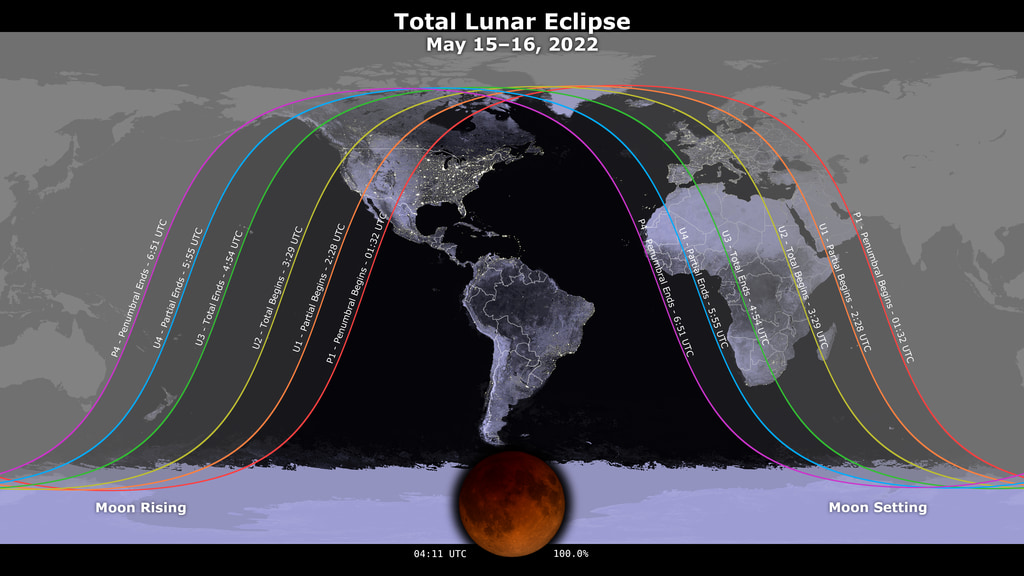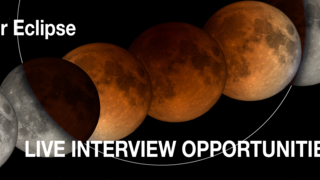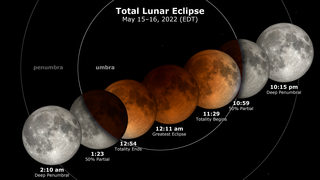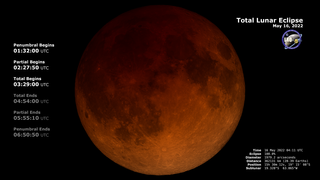Planets and Moons
ID: 4981
Also see the shadow diagram and Dial-a-Moon for this eclipse.
On May 16, 2022 (the night of May 15 in the Western Hemisphere), the Moon enters the Earth's shadow, creating a total lunar eclipse, the first since May of 2021. This animation shows the region of the Earth where this eclipse is visible. This region shifts to the west during the eclipse. Observers near the edge of the visibility region may see only part of the eclipse because for them, the Moon sets (on the eastern or right-hand edge) or rises (on the western or left-hand edge) while the eclipse is happening.
Contour lines mark the edge of the visibility region at the contact times. These are the times when the Moon enters or leaves the umbra (the part of the Earth's shadow where the Sun is completely hidden) and penumbra (the part where the Sun is only partially blocked). For observers located on a contour line, the contact occurs at moonrise (west) or moonset (east).

May 15-16, 2022 Total Lunar Eclipse: Visibility Map
On May 16, 2022 (the night of May 15 in the Western Hemisphere), the Moon enters the Earth's shadow, creating a total lunar eclipse, the first since May of 2021. This animation shows the region of the Earth where this eclipse is visible. This region shifts to the west during the eclipse. Observers near the edge of the visibility region may see only part of the eclipse because for them, the Moon sets (on the eastern or right-hand edge) or rises (on the western or left-hand edge) while the eclipse is happening.
Contour lines mark the edge of the visibility region at the contact times. These are the times when the Moon enters or leaves the umbra (the part of the Earth's shadow where the Sun is completely hidden) and penumbra (the part where the Sun is only partially blocked). For observers located on a contour line, the contact occurs at moonrise (west) or moonset (east).

Related
Visualization Credits
Ernie Wright (USRA): Lead Visualizer
Laurence Schuler (ADNET Systems, Inc.): Technical Support
Ian Jones (ADNET Systems, Inc.): Technical Support
Laurence Schuler (ADNET Systems, Inc.): Technical Support
Ian Jones (ADNET Systems, Inc.): Technical Support
Please give credit for this item to:
NASA's Scientific Visualization Studio
NASA's Scientific Visualization Studio
Short URL to share this page:
https://svs.gsfc.nasa.gov/4981
Mission:
LRO (Lunar Reconnaissance Orbiter)
Data Used:
Note: While we identify the data sets used in these visualizations, we do not store any further details nor the data sets themselves on our site.
This item is part of this series:
The Moon
Keywords:
SVS >> HDTV
SVS >> Lunar
SVS >> Moon
SVS >> Hyperwall
SVS >> LRO
SVS >> Lunar Reconnaissance Orbiter
SVS >> Eclipse
SVS >> Lunar Eclipse
NASA Science >> Planets and Moons
https://svs.gsfc.nasa.gov/4981
Mission:
LRO (Lunar Reconnaissance Orbiter)
Data Used:
DMSP/OLS/Earth at Night
JPL DE421 also referred to as: DE421
Ephemeris - NASA/JPL
Planetary ephemerides
This item is part of this series:
The Moon
Keywords:
SVS >> HDTV
SVS >> Lunar
SVS >> Moon
SVS >> Hyperwall
SVS >> LRO
SVS >> Lunar Reconnaissance Orbiter
SVS >> Eclipse
SVS >> Lunar Eclipse
NASA Science >> Planets and Moons














